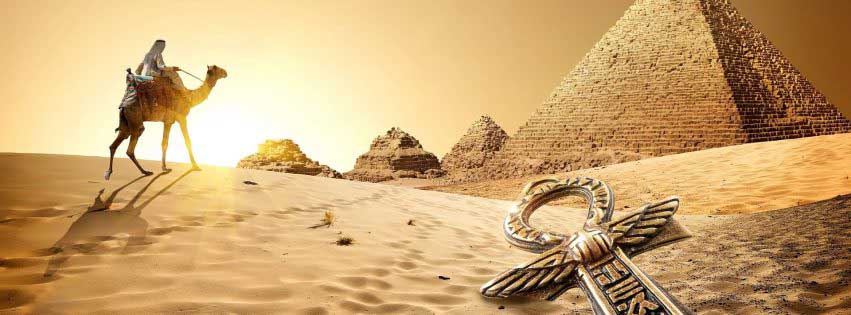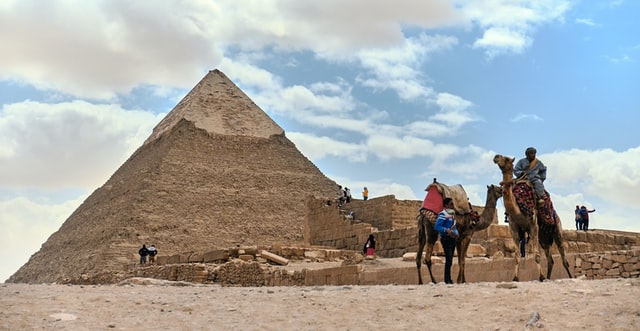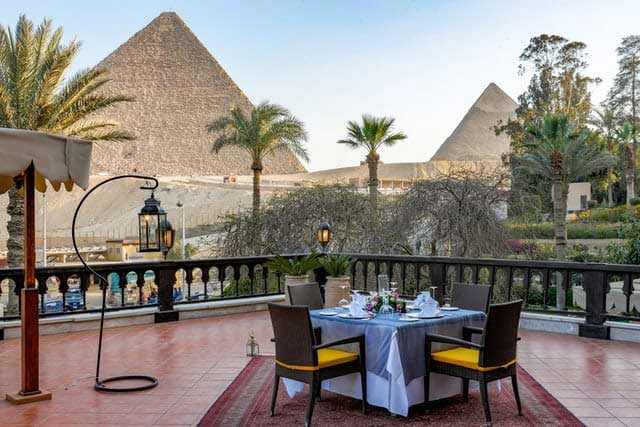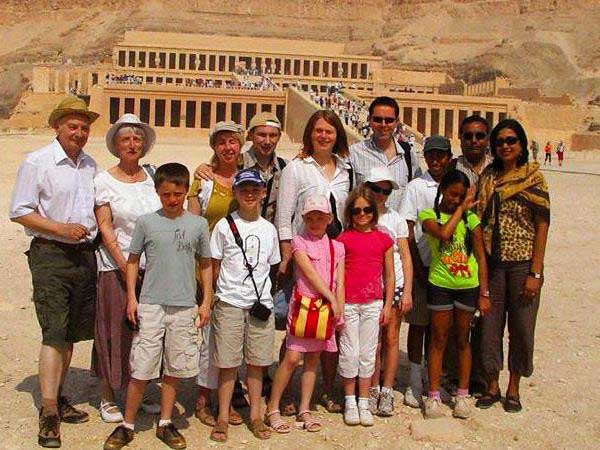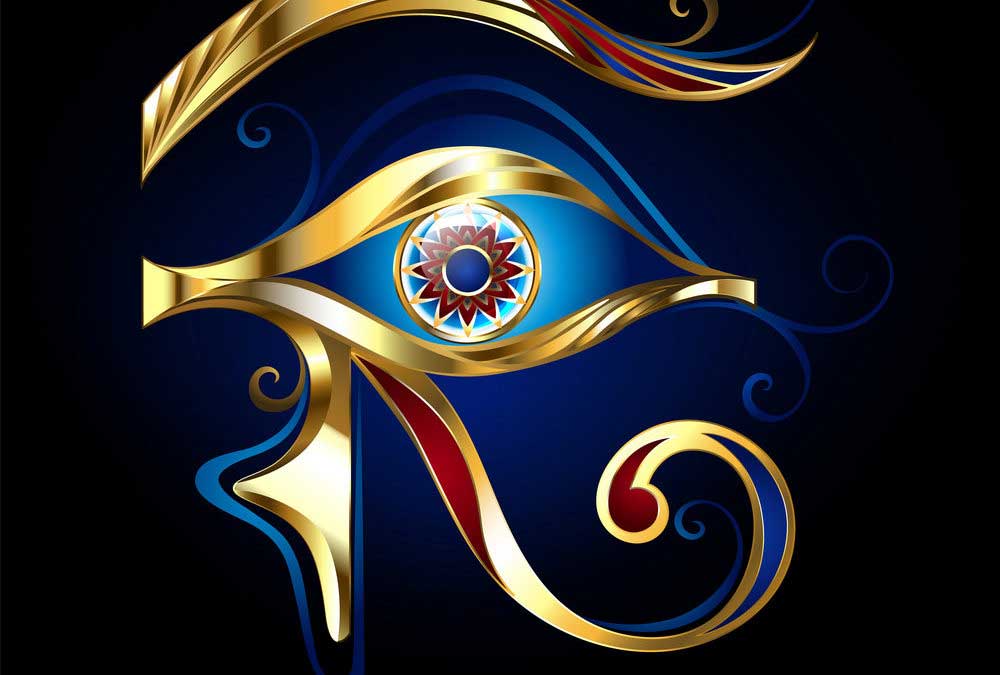Eye of Horus
As one of the most famous ancient Egyptian symbols, The eye of Horus has been considered a symbol of protection, victory, and royal power. The ancient Egyptians believed that Horus lost his left eye in a struggle with Seth, then Hathor magically helped Horus to restore it, and this restoration came to symbolize the process of making whole and healing. For this reason, the symbol was often used in amulets.
They also believed that Horus subsequently offered the eye to his deceased father Osiris, and its revivifying power sustained Osiris in the afterlife. The Eye of Horus was thus equated with funerary offerings as well as with all the offerings given to deities in temple ritual. It could also represent other concepts, such as the Moon, whose perceived waxing and waning was likened to the injury and restoration of the eye
This article will answer some of the frequently asked questions about the Eye of Horus including:
Who is Horus?
Horus is the divine son of the God Osiris and the Goddess Isis. The name “Horus” has multiple meanings, including “falcon,” “one who is above,” or “the distant one.”
The ancient Egyptian god Horus, son of Isis and Osiris, was a sky deity and many Egyptian texts say that Horus’s right eye was the Sun and his left eye the Moon. The solar eye and lunar eye were sometimes equated with the red and white crown of Egypt, respectively. Some texts treat the Eye of Horus seemingly interchangeably with the Eye of Ra, which in other contexts is an extension of the power of the sun god Ra and is often personified as a goddess.
He is one of the most renowned and beloved gods of the Ennead, the nine deities in Egyptian mythology worshipped at Heliopolis.
Horus is the God of Sky and representations from ancient Egypt show him as a man with the head of a falcon. In some hieroglyphs and artistic renditions, he is depicted as the falcon itself.
The ancients believed that Horus’s right eye depicted the sun, while his left eye depicted the moon, meaning he had dominion over all of heaven.
The origin of Horus is found in the myth of Osiris and Isis, which is widely known as the most famous myth of ancient Egypt. Osiris and Isis are represented as the male and female forces of the universe respectively in the eyes of the ancients.
The Egyptians believed that Osiris was the eldest son of the Goddess of the Sky, Stars, and Cosmos, Nut, and God of the Earth, Geb. He was the ruling king of Egypt and married one of his sisters, Isis, as was the Royal custom at that time.
Their marriage resulted in a son, Horus, the Sky God. Besides, Isis, Osiris had two other siblings, Set and Nephthys.
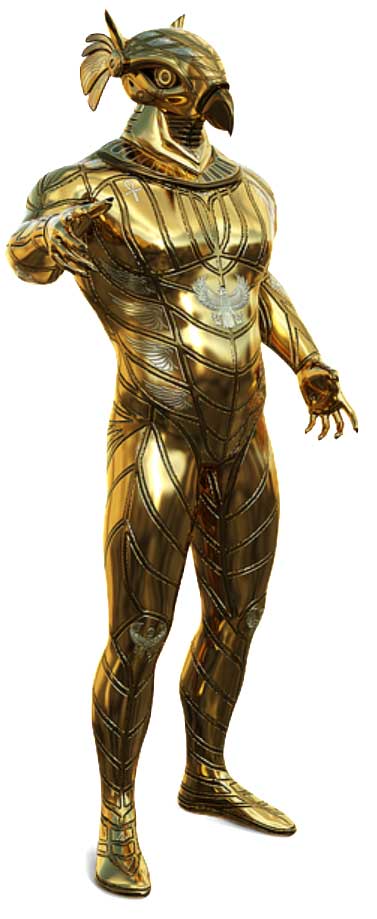
The Eye of Horus meaning
The Eye of Horus is an ancient Egyptian symbol that represents protection, sacrifice, healing, regeneration, and royal power. It is also used to protect both the living and the dead from evil forces.
During the fight between Horus and Set, both the gods sustained heavy injuries; Horus’s eye was ripped out and Set lost a testicle. The latter is used to indicate why the desert, which is represented by Set, is barren.
According to one version, Set tore out Horus’s eye and — like he did to Horus’s father — ripped his eye in six parts and threw them away.
In another version, it was Horus himself who tore out his eye to bring his father back to life. This illustrates why the Eye of Horus is considered to be a symbol of sacrifice.
After Horus lost his eye, it was restored magically. Some versions claim that Hathor, Goddess of the sky, fertility, beauty, and women, reconstructed his eye. Hathor is also believed to be Horus’s consorts. Others state that it was Thoth, the God of wisdom, magic, and moon, who gave Horus back his eye.
At this point, the Eye was called “Wadjet,” “Wedjat,” “Udjat” and “Wedjoyet” which translated to “whole and healthy.” Since it is widely believed that it was Horus’s left eye which was gouged out, it represented the waxing and waning of the moon.
The days in which there is no moon in the sky illustrates the time when Horus’s eye was ripped out, before being restored every lunar month.
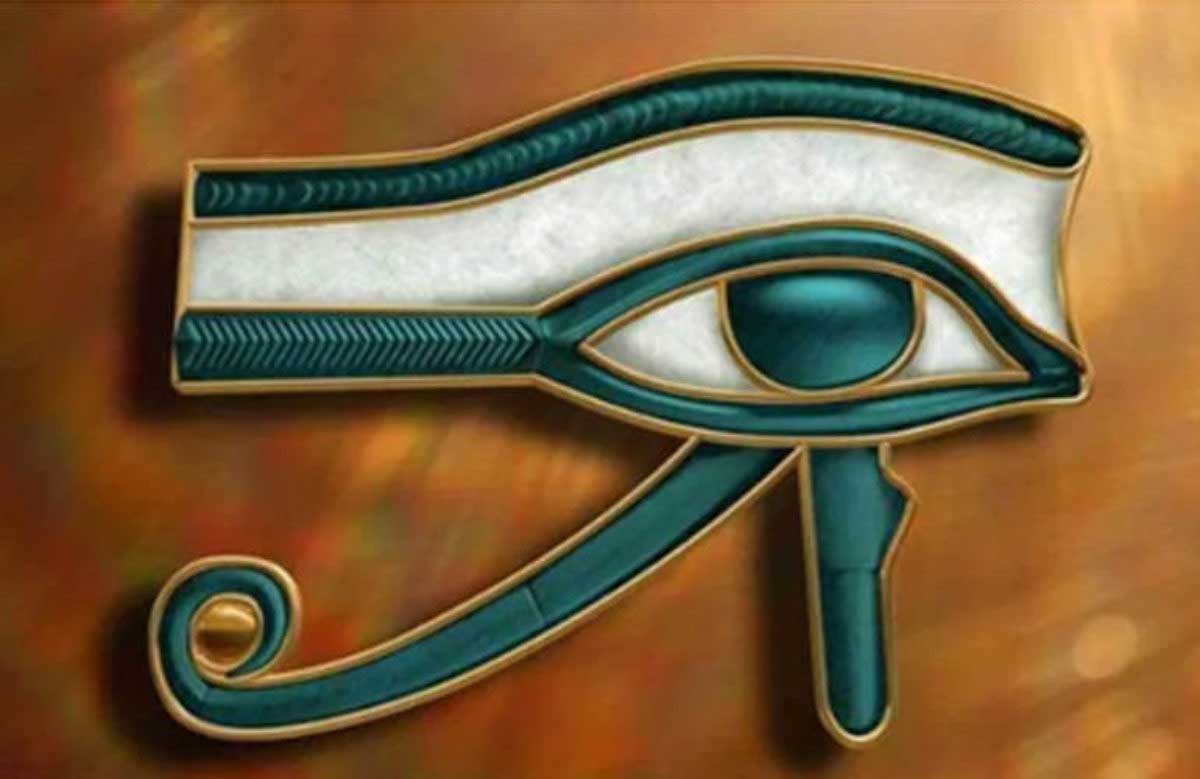
How Horus and Seth became enemies?
In ancient Egyptian myth, Osiris, the king of Egypt, was given all of the fertile land, while his brother, Set, received the barren deserts. Out of jealousy, Set murdered Osiris, claimed the throne, and brought chaos and disorder to Egypt.
Not only did Set kill Osiris, but because he wanted to keep him from entering the underworld, he cut his body up into 14 pieces and scattered them across the land. Ancient Egyptians believed that in order to enter the underworld, your body had to be intact, embalmed, and entombed.
Osiris’ wife, Isis, and his son, Horus, along with other family members, went on a quest to find all the pieces of his body. Isis then used her magic to resurrect him and he was then able to enter the underworld and become the god of the dead, of resurrection into eternal life, and the judge of the deceased.
Isis continued to raise Horus on her own and upon reaching adulthood, Horus went on a mission to avenge his father. In a series of fierce battles, Horus eventually defeated Set, but not without each of them sustaining heavy injuries. Set lost a testicle, and Horus lost one of his eyes.
In one version of the myth, Set tore out Horus’ eye, cut it into six pieces, and threw it away. In another version, it was Horus himself who gouged out his own eye as a sacrifice in hopes of bringing his father back to life. It is from this version of the myth that the Eye of Horus has become a symbol of sacrifice.
In any case, Horus’ eye was magically restored, either by Hathor, the goddess of the sky, women, fertility, and love, or by Thoth, the god of writing, magic, wisdom, and the moon. Because Horus’ eye was restored by magic, ancient Egyptians believed it had healing properties.

What was the ancient belief about the Eye of Horus?
Ancient Egyptians didn’t think of the eye as just a passive organ that we used for seeing the world; it was thought of as having special powers related to protection, taking actions, and anger. Eyes were thought to have powerful energy and could cast evil spells with just a glance. It was also believed that evil eyes could be counteracted with “good eyes”, which led to beliefs around the protective power of the Eye of Horus.
In hieroglyphics, the Eye of Horus is represented by seven different symbols, with the meaning of “take action” or “one who does”. Sailors harnessed its power by painting it on ships to protect them on dangerous voyages and to ward off evil forces. In this way, it is similar to the evil eye symbol.
It was also used in funeral monuments and amulets to offer the dead safety and protection on their journey to the underworld and to ensure a good and safe afterlife.
How the eye is used nowadays?
Today, the Eye of Horus is still used for protection against evil forces and is also believed to bring good health, rejuvenation, energy, and vitality to its wearer.
It is placed in homes to improve safety and security from both physical and emotional dangers. It is also used in magic spells, to keep negative energy away and to attract positive energy.
What is The significance of Eye of Horus?
Since Egyptian mythology is fluid, the Eye of Horus has come to symbolize many things. The shape of the eye itself is quite complex and has given rise to different interpretations.
The symbol of the Eye of Horus is a highly stylized eye and an eyebrow. The dual lines extending from the bottom of the lash represent the markings on the falcon symbol of Horus.
The Eye comprises of an arched eyebrow line that tapers into a straighter horizontal line at the top.
Below it is an almost-parallel line that denotes the top of the eye. Another arched line below it connects to the horizontal taper of the top of the eye.
Between them is the iris or pupil, which is often colored blue. Off-center towards the right is a vertical line that mimics a teardrop and this is often simply known as the “tear.” The last element of the eye is a long curved line that starts from where the tear originates, extends to the left and ends in a curlicue.
Although the physical representations are easy to see, the Eye of Horus has deeper meanings incorporated into every line and it follows precise laws. In fact, the shape of the eye is significant to human neuroanatomy.
• One of the names of the Eye of Horus is the Eye of Mind, which can be illustrated by the eyebrow which was believed to denote thought and wisdom.
• The pupil represents the sense of sight.
• The triangular shape that is made up of the space between the pupil and the inside of the eye symbolizes the sense of hearing.
• The triangular shape that is made up of the space between the pupil and the outer corner of the eye symbolizes the sense of smell.
• The curving line that ends in a spiral denotes the tongue and the sense of taste.
• The tear represents the sense of touch.
Intriguingly, the shape of the Eye of Horus also closely resembles the anatomy of the brain.
The eyebrow is identical to the corpus callosum, the pupil is identical to the interthalamic adhesion, the triangular shape that corresponds to hearing is identical to anterior transverse temporal lobe and posterior transverse temporal lobe, the triangular shape that corresponds to smell represents the olfactory trigone, the tear represents the somatosensory pathway and the curling line represents the taste pathway.
What is The Mathematical significance of Eye of Horus?
The eye of Horus also holds a mathematical knowledge as each piece of the six-part of the eye is given a fraction as a unit of measurement the right side of the eye is 1/2, the pupil is 1/4, the eyebrow is 1/8, the left side of the eye is 1/16, the curved tail is 1/32, and the teardrop is 1/64. All these fractions add up to 63/64, and the missing part is believed to either represent the magical abilities and powers of Thoth or to illustrate the notion that nothing is truly perfect.
Besides the mathematical significance, each part had a connection with a different sense, the right side of the eye is associated with the sense of smell because it is the closest to the nose and resembles the organ. The pupil represents the sense of sight, while the eyebrow represents thought because it can be used to express our thoughts. The left side of the eye represents the sense of hearing because it points towards the ear, and resembles a musical instrument. The curved tail corresponds to the sense of taste because it resembles a sprout from a planted stalk of wheat or grain.
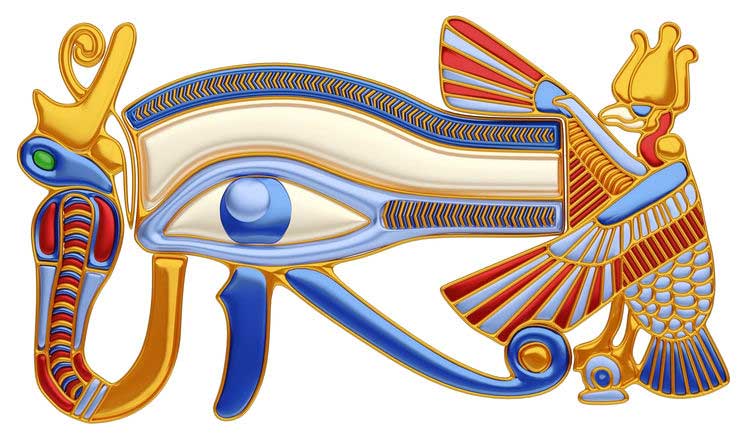
What is the difference between the Eye of Ra and Eye of Horus?
The Eye of Ra is similar to the Eye of Horus and represents many of the same concepts.
Eye of Ra (Right Eye)
• Related to the Sun
• Symbol of protection
• Symbol of power
• Symbol of good luck
• Represents fertility, birth and femininity
• Represents aggression and danger when provoked
Eye of Horus (Left Eye)
• Related to the Moon
• Symbol of protection
• Symbol of power
• Symbol of wellbeing and health
• Symbol of sacrifice
• Used to ward off evil
• Used as a measuring system
The ancient Egyptians often called the sun and the moon the “eyes” of gods. For instance, the right eye of Horus was referred to as the sun, while his left eye was referred to as the moon.
However, in Egyptian mythology, many concepts are fluid, so at times, Egyptians called the moon the Eye of Horus, and called the sun, the Eye of Ra.
Like the sun, the Eye of Ra is the source of light and heat and is closely linked to the element of fire. It is also associated with the red light of the dawn and the morning star that signals the arrival of the sun.
Since the sun brings the new day, so the life-giving powers of the Eye of Ra were celebrated in many rituals. Conversely, its violent aspects were invoked while protecting the pharaoh, holy places, or the common people.
Both The Eye of Horus and The Eye of Ra offer great protection, however, it is the way this protection is demonstrated that separates the two. It is also generally believed that while the left eye symbolizes Horus, the right eye symbolizes Ra.
Is the Eye of Horus related to the brain?
The Eye of Horus is not just magical; it also corresponds to the neuroanatomical features of humans. If the Eye is superimposed over the median cut of the brain, each of its six parts relate to six essential areas of the human brain, i.e. the corpus callosum, the interthalamic adhesion, anterior transverse temporal lobe and posterior transverse temporal lobe, the olfactory trigone, somatosensory pathway, and the taste pathway.
Is the Eye of Horus the Third Eye?
The Eye of Horus has been known by many names and is closely associated with the “Third Eye,” “the Eye of the Mind,” and the “Eye of Truth and Insight.”
Therefore, Egyptologists also believe that the Eye of Horus may be the precursor of the other significant eyes that have appeared in other cultures. Most notably, Shiva, one of the gods in Hindu theology, is always represented with a third eye on his forehead which represents the crown chakra and provides perception beyond simple sight.
In Buddhism, the Buddha is referred to as the “Eye of Truth” or the “Eye of the World.”
Travel packages to Egypt including the temple of Horus:
Frequently asked questions about visiting Egypt
Is it safe to travel to Egypt
Is it safe to travel to Egypt?
Is Egypt Safe for Americans to Travel to
Is Egypt Safe for Americans to Travel to?
We get this question a lot at Bastet Travel In short, Americans and other visitors can rest easy: yes, Egypt is a safe country for tourists. And the rest of the world seems to agree — after years of middling numbers, tourism in Egypt is steadily rising towards its former highs, hosting over 9 million sightseers in 2018. The longer answer is worth exploring, though, and we have some assurances to offer all our clients who join us on all of our Egypt Travel Packages.Is a negative COVID-19 test (PCR and/or serology) required for entry?
- Yes.
- All passengers travelling to Egypt (including Egyptians) must be in possession of negative PCR test certificate for COVID-19, taken at a maximum of 72 hours before their flight departure time.
- Passengers travelling from Japan, China, Thailand, North America, South America, Canada, London Heathrow, Paris, and Frankfurt will be allowed to provide the test certificate performed at a maximum of 96 hours prior to flight departure, due to the long travel and transit period from these airports.
- Although we understand the PCR testing policy to require a test result performed no more than 96 hours before the original departing flight, we have received anecdotal reports that some travelers have been denied entry when their PCR test was performed more than 96 hours prior to the departure of their connecting flight.
- Travelers must present paper copies of the test results; digital copies will not be accepted.
- Children under the age of six of all nationalities are exempt.
Are PCR and/or antigen tests available for US citizens in Egypt?
Yes, at numerous private testing centers, as well as the Central Public Health Lab.
Has the government of Egypt approved a COVID-19 vaccine for use?
Yes
Which vaccines are available in Egypt?
AstraZeneca and Sinopharm.
Are vaccines available in Egypt for tourists to receive?
Yes, the media has reported that anyone over age 18, including foreign residents, can now register for the vaccine. There is limited supply of the vaccine available and the media reports that priority for the vaccine will go to the elderly and those with chronic illnesses.
Are test results reliably available within 72 hours?
Yes. Most test providers offer 48-hour turnaround. Faster service is possible at extra cost.
How can I obtain my Visa to visit Egypt?
How can I obtain my visa to visit Egypt?
What do i need to know when traveling to Egypt?
A few Things to Know Before Traveling to Egypt
You need a visa, and you can buy it upon arrival. The dollar goes far in Egypt. The traffic in Cairo/Giza is outrageous, but taxis (and Ubers) are cheap. You should not skip the Pyramids and Sphinx. The Pyramids and Sphinx are just the beginning of the ancient treasures. Islamic Cairo is amazing. Aswan should not be missed The Sahara is more than sand It is safer than you thinkWhat are the best day trips in Egypt
What are the best day trips in Egypt?
The best Day Trips in Egypt according to our travelers are: Cairo & Giza Tour Alexandria city full-day tour. Private Pyramids, Saqqara, and Memphis full-day tour Cairo Full-Day Private Guided City Tour Luxor East and West bank tourWhat are the most famous tourist attractions in Egypt
What are the most famous tourist attractions in Egypt?
Egypt has so much for travelers to see and do, it’s the perfect country for a mix of activities combining culture, adventure, and relaxation. Find the best places to visit with our list of the top tourist attractions in Egypt.- Pyramids of Giza
- Valley of the kings
- Luxor’s Karnak Temple
- The Egyptian Museum
- Christian and Islamic Cairo
- The White Desert and Baharyia Oasis
- Siwa Oasis
- Abu simbel Temples
- Aswan
- Alexandria
- St. Catherine’s Monastery
- The Nubian village
- Nile River Cruise
- Hurghada
- South of Sinai
Related Articles
Related
Seth
Also known as Set, Setekh, Suty and Sutekh, Seth was the god of chaos, darkness, violence, evil, deserts, storms, and one of the Osirian gods. In the Osiris myth, he is the murderer of Osiris (in some versions of the myth, he tricks Osiris into laying down in a coffin and then seals it shut.)
Ancient Egyptian Gods And Goddesses
For all ancient Egyptians, the world was filled with mystery. Much of what they experienced in the world around them was unknowable and frightening. The ancient Egyptian gods and goddesses represented aspects of the Egyptians’ natural and “supernatural” surroundings and helped them understand its many aspects.
Horus
Depicted as a falcon or as a man with a falcon’s head, Horus was a sky god associated with war and hunting. He was also the embodiment of the divine kingship, and in some eras the reigning king was considered to be a manifestation of Horus.



